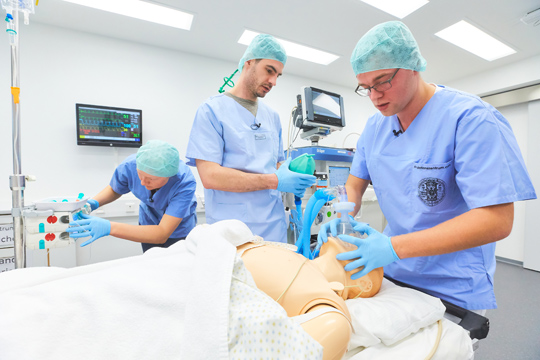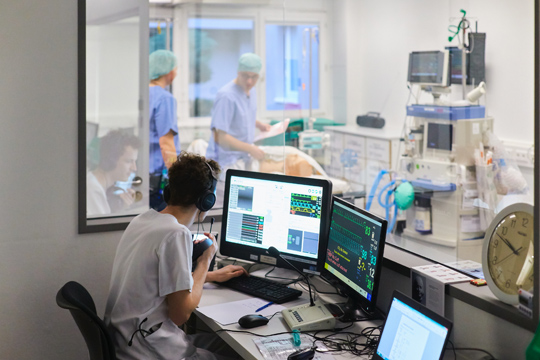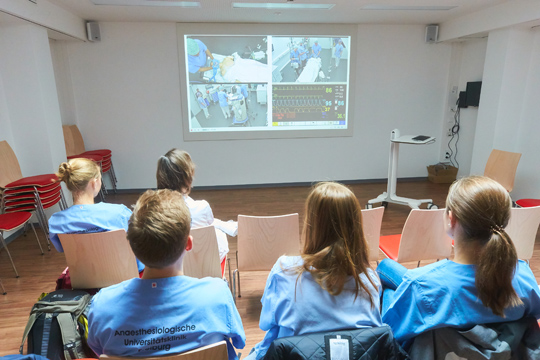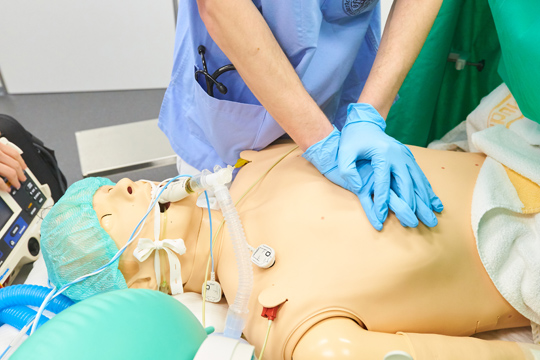“So have you already thought about what you are going to dream?”
Freiburg, Apr 11, 2019
Gall bladder removal, inguinal hernia surgery, meniscus rupture treatment: Since October 2018, future physicians at the University of Freiburg have the opportunity to train in a simulation center equipped with modern technology for their professional everyday lives to come. In the operating room in particular the following rule applies: Those who are well prepared will keep their cool.

In the simulation center, medical students apply their theoretical knowledge under realistic conditions such as in the case of anesthesia here by putting a patient under. Photo: Harald Neumann
Anesthetist Fabian Drewitz has a problem: The respiratory mask is not snuggly situated on his patient's mouth and nose; he has to press hard so that the man can get enough oxygen. Drewitz is supposed to put the patient under an anesthetic for a routine hernia operation. The surgical team is already waiting. “Are the curves okay?” he asks. “Blood pressure is okay, respiratory minute volume is somewhat low,” answers medical student Alina Domdey, who is standing next to him while looking at the monitor. Nurse Gabriel Christmann has the anesthetic ready: “One milligram per kilo of body weight - is that right?”
In reality Fabian Drewitz is not an anesthesiologist and Gabriel Christmann is not a nurse. Only Alina Domdey is playing the role as herself in this scenario. All three of them are medical students in their final year, also known as their 'Practical Year' (PJ). This morning, they will practice in a new facility at University Medical Center Freiburg called the Freiburger Anästhesiologie- und Chirurgie-Trainings- und Simulationszentrum für Studierende (“Freiburg Anesthesiology and Surgery Training and Simulation Center for Students”) or FACTS-S for short. The operating and wardrooms have been reconstructed in four practice rooms, equipped with the proper technology. The Baden-Württemberg State government, the University Medical Center and the University of Freiburg have invested nearly 1.2 million euros in the center. Surgery students also practice here minimally invasive procedures such as knee mirroring or the removal of gallbladders.

Jonathan Appelt uses a computer to control the behavior and vital functions of the plastic patient. Photo: Harald Neumann
Real experience, sustainable learning effect
“In anesthesia, students cannot do a lot by themselves because a real anesthetic is always done by a licensed physician," says Dr. Axel Schmutz, senior physician in charge of teaching at the hospital's anesthesia department. “Furthermore, it is not known when a patient will have a relevant problem, such as circulatory arrest. However, I would like students to be able to learn the practical procedure for certain clinical constellations in a targeted way.” It is best done in a realistic environment - which is why a simulation center in which scenarios can be realistically portrayed is so important: “Real-life experience is the best teacher. In this way, we create a good bridge from theory to practice for the students.”
Today, Peter Schmidt, the patient with the inguinal hernia, is lying on the operating table in one of the “operating rooms.” Mr. Schmidt is made of plastic, he has a lot of technology surrounding him: the students can, for example, provide mask respiration, insert a breathing tube and administer medication through the arm; a monitor displays important data such as heart rate and oxygen saturation. Mr. Schmidt can also speak: his voice comes from Jonathan Appelt, he is a training assistant and sits behind a mirrored window in a type of control room.
Feedback from classmates
From there, it uses a computer to control the behavior and vital functions of the plastic patient. When the trio enters the room at the beginning of the scenario, Mr. Schmidt says: "I am very nervous." For a moment the students are insecure, but then they take on their roles and introduce themselves to the patient one after the other. As a doctor, Fabian Drewitz double-checks by asking him his name and date of birth, then explains briefly what the team will do, and tries to alleviate the patient's nervousness by joking: “So have you already thought about what you are going to dream?”

Those who are passive observers can watch from the next room: on a screen, the scenario can be seen from three different camera positions. Photo: Harald Neumann
Meanwhile, the other six students in the course are sitting in an adjoining room. They can observe the scenario on a screen from three different camera positions while listening to the voices of the participants. The patient's vital signs are also displayed. They can observe how their colleagues put Mr. Schmidt under a proper anesthetic despite his nervousness and the poorly fitting mask. When the three come back to the others in the room after about 20 minutes, there is first of all praise from a fellow student: "Congratulations - considering how completely overwhelmed you were with both the situation and the equipment, you did a great job."
Those who are well prepared will keep their cool
Dr. Anu Huotari also thinks it’s not bad for the first time. Today the specialist is leading the training together with her colleague Dr. Axel Semmelmann. Together they go through the anesthesia again, looking at individual recorded scenarios. “Try to imagine the situation as a whole before starting as a team: What kind of patient is this, what exactly do we want to do, what are the risks,” says Huotari. “It will give you peace of mind if you are well prepared,” adds Semmelmann, "which is also important from a psychological perspective.”

Peter Schmidt is lying on the operating table: the patient, equipped with modern technology, can help medical students practice medical routines without taking any risks. Photo: Harald Neumann
The two specialists are present at all exercise scenarios and available in the event of technical glitches - but otherwise they keep out of it. The students have to take the helm themselves. They then discuss all scenarios, such as an allergic shock with cardiovascular and respiratory arrest during an operation and a ventilator defect that occurred that morning. One topic that both of them repeatedly address is communication, especially in stressful situations: "Speak clearly, it is very important that the whole team has the same information," Huotari intones the student.
In the end, the three-person team around the patient Peter Schmidt is completely satisfied. “That was like jumping off the deep end," says Fabian Drewitz. “This is only our third day in anesthesia.” Classmate Alina Domdey adds: “It’s good that in a real-life simulation you are constantly thinking about what you can do in that given moment - and then you get to see the reaction right away: I provide adrenaline and the patient won’t collapse.”
Thomas Goebel

